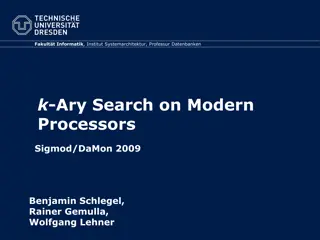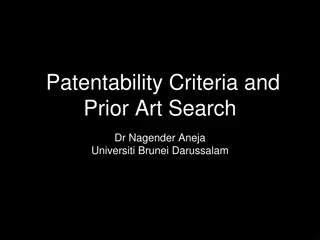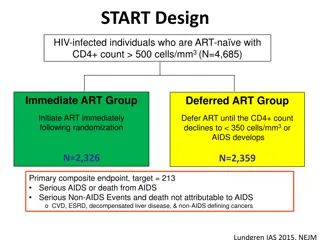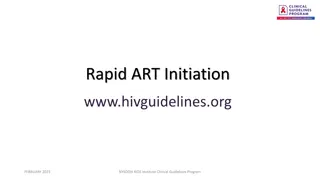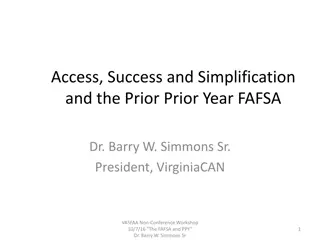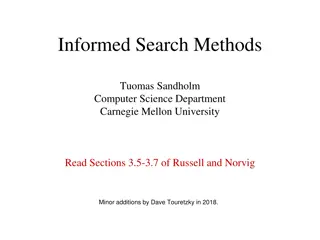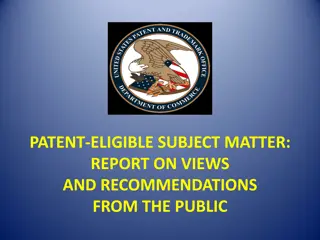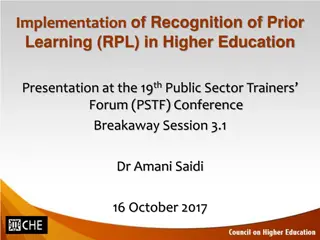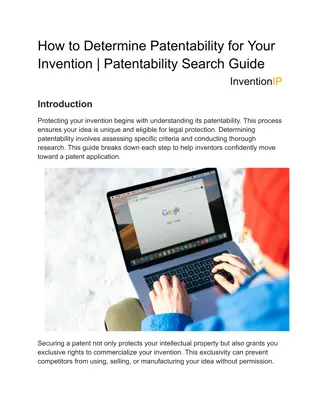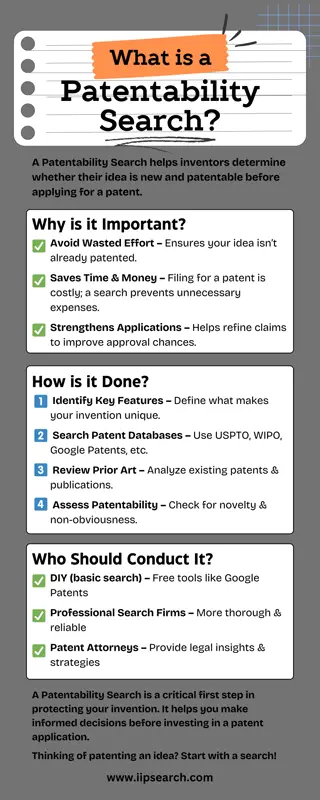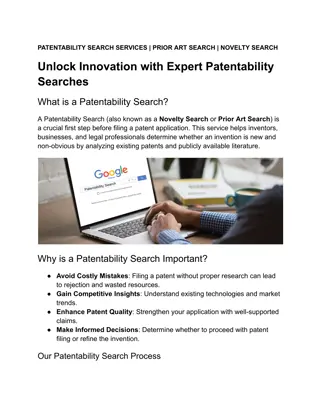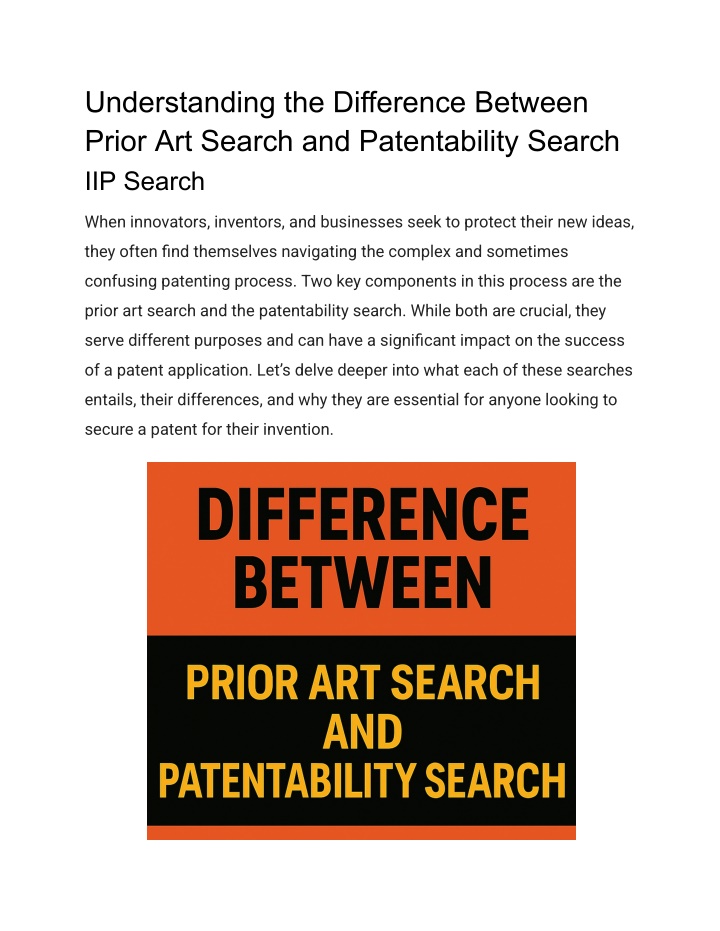
Prior Art Search vs Patentability Search: Key Differences & Importance
Understanding the difference between a prior art search and a patentability search is crucial for securing a patent. While a prior art search identifies existing inventions to assess novelty, a patentability search goes further, evaluating whether an
Download Presentation

Please find below an Image/Link to download the presentation.
The content on the website is provided AS IS for your information and personal use only. It may not be sold, licensed, or shared on other websites without obtaining consent from the author. If you encounter any issues during the download, it is possible that the publisher has removed the file from their server.
You are allowed to download the files provided on this website for personal or commercial use, subject to the condition that they are used lawfully. All files are the property of their respective owners.
The content on the website is provided AS IS for your information and personal use only. It may not be sold, licensed, or shared on other websites without obtaining consent from the author.
E N D
Presentation Transcript
Understanding the Difference Between Prior Art Search and Patentability Search IIP Search When innovators, inventors, and businesses seek to protect their new ideas, they often find themselves navigating the complex and sometimes confusing patenting process. Two key components in this process are the prior art search and the patentability search. While both are crucial, they serve different purposes and can have a significant impact on the success of a patent application. Let s delve deeper into what each of these searches entails, their differences, and why they are essential for anyone looking to secure a patent for their invention.
What is a Prior Art Search? A prior art search is the process of looking through publicly available information to find existing inventions, products, or technologies that may be similar to the idea you re attempting to patent. The primary objective of this search is to determine whether your idea is truly original or if it has already been disclosed in some form. Prior art can include patents, patent applications, research papers, journal articles, product manuals, conference proceedings, and even public disclosures on websites or blogs. Why is Prior Art Search Important? The prior art search helps to establish the novelty of your invention. According to patent laws, an invention must be novel, meaning it should not have been publicly disclosed before the filing of the patent application. By conducting a prior art search, you can identify if your invention has already been disclosed in some form, thereby saving you from pursuing a patent for an idea that cannot be patented. This search helps you avoid wasted time, resources, and money. Key Components of a Prior Art Search: Patent Databases: A thorough search of existing patents and patent applications in relevant databases such as USPTO, EPO, WIPO, or national patent offices. Non-Patent Literature: Research papers, journals, whitepapers, conference proceedings, and other technical publications.
Existing Products: Search for products on the market or prototypes that may resemble your invention. What is a Patentability Search? A patentability search is a more focused and in-depth investigation into whether an invention meets the legal criteria for patent protection. While a prior art search mainly identifies existing knowledge, a patentability search assesses whether your invention meets the following criteria: Novelty: The invention must be new and should not have been disclosed by prior art. Inventive Step (Non-Obviousness): The invention must not be obvious to someone skilled in the relevant field based on the prior art. Industrial Applicability: The invention must be useful in some industry or field. A patentability search aims to provide a more comprehensive analysis of the chances of success in obtaining a patent. It not only checks for similar inventions but also evaluates the legal requirements for patentability. Why is Patentability Search Important? A patentability search allows inventors to determine whether their idea has a realistic chance of being granted a patent. It provides an assessment of whether the invention meets the legal standards required by patent offices.
This search is usually conducted just before filing a patent application to avoid the risk of rejection based on novelty or obviousness. Key Components of a Patentability Search: Novelty Check: Verifies whether the invention is truly novel by comparing it to prior patents, publications, and products. Inventive Step: Assessing whether the invention involves an inventive step that is not obvious to someone skilled in the field. Legal Criteria Evaluation: Ensuring that the invention satisfies all legal requirements for patentability, including industrial applicability. Differences Between Prior Art Search and Patentability Search Understanding the distinction between these two searches is essential to navigating the patent process effectively. While they may seem similar, there are several key differences between a prior art search and a patentability search. 1. Purpose of the Search Prior Art Search: Focuses on determining whether similar inventions or ideas already exist. It mainly identifies whether the idea has been disclosed before in patents, publications, or existing products.
Patentability Search: Takes a deeper approach by not only evaluating prior art but also assessing whether the invention meets all the legal requirements for patentability. It helps determine whether the invention is truly patentable. 2. Depth of Search Prior Art Search: Primarily seeks to identify patents and non-patent literature that disclose similar inventions. The scope is generally broader and looks for any prior disclosure, including publications, websites, or existing patents. Patentability Search: Involves a more in-depth analysis of the prior art found, focusing on the legal requirements for patentability. It evaluates inventive steps, novelty, and industrial applicability in detail. 3. Timing of the Search Prior Art Search: Typically conducted early in the research and development phase, helping innovators understand the landscape of existing inventions. Patentability Search: Conducted later, typically before filing a patent application, to determine whether the invention qualifies for patent protection. 4. Outcome of the Search
Prior Art Search: Provides a general understanding of whether an invention is novel or if similar inventions already exist. Patentability Search: Offers a more comprehensive analysis, including an assessment of whether the invention meets all patentability criteria. When Should You Conduct Each Search? Prior Art Search It is advisable to perform a prior art search early in the development process to avoid wasting resources on inventions that lack novelty. This search helps to identify potential areas for innovation and allows businesses to refine their ideas before investing heavily in the patent process. Patentability Search A patentability search should be conducted once an inventor is ready to file a patent application. This search provides a clearer picture of whether the invention meets the legal criteria for patentability, increasing the chances of patent approval. Case Studies of Prior Art and Patentability Searches Case Study 1: Tech Startup s Prior Art Search A tech startup has developed a new type of smartphone battery with improved charging capabilities. Before filing for a patent, they conducted a
prior art search and found a patent that disclosed a similar technology. This discovery helped the company pivot and refine their invention to ensure it was truly unique before proceeding with a patent application. Case Study 2: Biotech Company s Patentability Search A biotech company invented a new drug delivery system and was ready to file a patent application. Before doing so, they conducted a patentability search to ensure their invention met the novelty, non-obviousness, and industrial applicability criteria. The search revealed that their invention was indeed novel and met all the necessary legal standards, boosting their confidence before filing the application. FAQs: 1. Can a prior art search guarantee that my patent will be granted? No, a prior art search can only help identify whether similar inventions exist. It does not guarantee that your patent application will be approved, as the patentability search looks at additional legal criteria like non-obviousness. 2. How long does a prior art or patentability search take? The duration depends on the complexity of the technology and the scope of the search. A typical search can take anywhere from a few days to several weeks. 3. Can I conduct a prior art or patentability search myself?
While you can conduct a search yourself using patent databases and online tools, it is advisable to hire a professional patent search firm. They have the expertise to conduct a thorough and accurate search. 4. Is a prior art search mandatory before filing a patent? No, it is not mandatory, but it is highly recommended. A prior art search helps you determine the novelty of your invention, reducing the risk of patent rejection. Conclusion Both prior art searches and patentability searches are crucial tools for anyone looking to protect their inventions through patents. While a prior art search focuses on identifying similar inventions, a patentability search goes a step further by assessing the legal criteria for patent protection. Together, these searches help inventors make informed decisions about pursuing patents and can significantly increase the likelihood of success in the patent application process. For a detailed patentability search tailored to your needs, visit IIP Search s Patentability Search Service. Start your journey to patent protection with confidence today!





